Decoding Perimenopause
Perimenopause, often termed the menopausal transition, refers to the phase of natural hormonal changes leading up to menopause, signifying the conclusion of reproductive years. This critical time, coined as “around menopause,” holds profound significance in every woman’s life.
The Evolution and Variability of Perimenopause
The onset of perimenopause varies among women, with some experiencing it in their 30s while others noticing changes in their 40s. The hallmark of this phase is the erratic rise and fall of oestrogen, the primary female hormone. These hormonal shifts manifest as irregularities in menstrual cycles, accompanied by symptoms akin to menopause.
Symptoms: Navigating the Transition
As your body navigates the intricate path to menopause, you may encounter a spectrum of changes:
- Irregular Periods: Ovulation becomes unpredictable, causing variations in menstrual cycle lengths, flow intensity, and potential skips. Early perimenopause can be indicated by a persistent change of seven days or more in cycle length, while late perimenopause might be signaled by intervals of 60 days or more between periods.
- Hot Flushes and Sleep Disturbances: Hot flushes, common in perimenopause, vary in intensity, duration, and frequency. Sleep disruptions, often triggered by hot flushes or night sweats, can lead to unpredictable sleep patterns.
- Mood Fluctuations: Mood swings, irritability, or susceptibility to depression may arise during perimenopause. These mood changes might also stem from factors beyond hormonal shifts.
- Vaginal Health Concerns: Diminishing oestrogen levels can lead to vaginal dryness, discomfort during intercourse, and vulnerability to urinary or vaginal infections. This phase might also witness a decrease in fertility.
- Changing Sexual Dynamics: While sexual desire and arousal might change, many individuals report a decrease in libido during perimenopause. It’s important to note that the impact on sexual intimacy varies among individuals.
- Bone Health and Cholesterol Levels: The declining oestrogen levels put you at risk of accelerated bone loss and thus elevating the susceptibility to osteoporosis. These hormonal shifts might also impact cholesterol levels, potentially increasing heart disease risk.
Learn more about menopause symptoms here by the NHS.
Transition to Menopause: A Pivotal Milestone
Perimenopause concludes once you’ve experienced 12 consecutive months without a menstrual period, marking the official arrival at menopause. This transition underscores the cyclical nature of reproductive life.
Exploring the Link to Menopause
Perimenopause and menopause are interconnected phases in a woman’s journey. The symptoms, experiences, and challenges of perimenopause lay the groundwork for the eventual transition into menopause. Understanding perimenopause equips you with insights into the changes that lie ahead.
Causes and Risk Factors: Unveiling the Mechanism
The ebb and flow of oestrogen and progesterone, fundamental female hormones, shape the landscape of perimenopause. These hormonal shifts, particularly the decline in oestrogen, drive the changes during this phase.
Risk Factors: Navigating the Uncharted Territory
While menopause is a universal phase, its onset varies. Certain factors may influence the timing of perimenopause:
- Smoking: Women who smoke may experience perimenopause 1 to 2 years earlier than non-smokers.
- Family History: A family history of early menopause can predispose women to experience it themselves.
- Cancer Treatment: Treatments like chemotherapy or pelvic radiation therapy may accelerate the onset of perimenopause.
- Hysterectomy: Although a hysterectomy that preserves ovaries generally doesn’t induce menopause, it might lead to early menopause. Surgical removal of one ovary can also hasten its cessation.
Complexities and Seeking Medical Care
Irregular periods are common in perimenopause, yet certain signs warrant medical attention:
- Excessively heavy bleeding requiring frequent tampon/pad changes
- Bleeding lasting over seven days
- Bleeding between periods
- Cycles recurring in less than 21 days
Such indications might signify underlying reproductive system issues requiring diagnosis and treatment.
Learn more about our team
Follow us on socials


